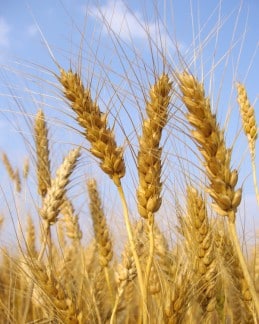Gluten: What is it? Where is it? Should I avoid it? What do I eat instead?
It wasn’t until a few years ago that I first started hearing the word ‘gluten’ but lately it seems to be all over the place. There are articles and talk show segments and even whole books dedicated to the topic. As someone who likes to stay up to date on the latest health and wellness news, I decided to do some research and make a cheat sheet of all the need-to-know gluten and going gluten free (aka G-Free) facts. Then, I figured since I am already doing all of the work, I might as well share my cheat sheet with you!
What is Gluten?
Gluten is a protein found in wheat, barley and rye that helps with elasticity, texture and rising.
What’s Gluten In?
Anything with wheat, barley or rye in it has gluten. This includes:
- Flour (bleached white flour, whole wheat, cracked wheat, barley, semolina, spelt, farro, kamut, triticale) or vital wheat gluten
- Semolina, spelt and whole wheat pasta, including cous cous
- The MAJORITY of beer, ale and lager
- Brats, meats and sausage cooked in beer
- Malt vinegar, malt flavorings and barley malt
- Recipes calling for breadcrumbs, breaded coatings, flour dredging, bread and flat bread, croutons, bagels, croissants, flour tortillas, pizza crust, graham crackers, granola, cereal, wheat germ, wheat berries, cookie crumbs, pie crust, crackers, pretzels, toast, flour tortillas, wraps and lavash, or pita bread
- The vegan protein sub called seitan
- Barley enzymes used in malt, natural flavors, and to process some non-dairy beverages, chocolate chips, coffee and dessert syrups (and even some brown rice syrups)
-Gluten Free Goddess
Why would someone consider eliminating Gluten from their diet?
- Celiac Disease- Celiac Disease (CD) is a lifelong inherited autoimmune condition affecting children and adults (about 1 in 133) where the protein molecules in wheat, barley and rye trigger an autoimmune response that results in damage to the small intestine, along with other related problems.
- Between 5% and 10% of all people may suffer from a gluten sensitivity of some form
-National Institutes of Health, Univ. of Chicago Celiac Disease Center
- Benefits of little or no Gluten in diet- If you do not have Celiac Disease or a gluten intolerance, you do not need to eliminate gluten entirely from your diet. However, cutting gluten from the areas of your diet where it does not need to be (as fillers and additives and packaged and processed food) and making simple swaps will lead you to feeling and being healthier.
If you are seeking a gluten-free diet, you’ll want to avoid the following foods (in general) unless they’re labeled as gluten-free or made with corn, rice, soy or other gluten-free grain:
- Beer
- Breads
- Cakes and pies
- Candies
- French fries
- Gravies
- Imitation meat or seafood
- Matzo
- Pastas
- Processed luncheon meats
- Salad dressings
- Sauces, including soy sauce
- Seasoned rice mixes
- Seasoned snack foods, such as potato and tortilla chips
- Self-basting poultry
- Soups and soup bases
- Vegetables in sauce
-MayoClinic.com
Swap THIS for THAT
Pasta:
- 100% Corn pasta
- Quinoa and corn pasta
- Soy pasta (if it states gluten-free)
- Brown and white rice pasta, rice noodles, rice glass noodles
- 100% buckwheat soba noodles (check label)
Flour Tortillas: (at almost 1/3 the calories too!!!) 100% corn tortillas and taco shells with a gluten-free label
Alternative grains, flours, starches and thickeners:
- Corn, grits, polenta and cornmeal
- Buckwheat, buckwheat cereal, kasha and buckwheat flour
- Rice- white, brown, risotto, basmati, jasmine, sticky rice, rice cereal
- Rice flour- white rice, sweet (glutinous) rice and brown rice flour
- Quinoa, quinoa cereal flakes, and quinoa flour
- Millet and millet flour
- Sorghum flour
- Amaranth and amaranth flour
- Certified gluten-free oats and oatmeal(milled from a dedicated GF source)
- Coconut flour
- Teff flour
- Nut meals and flours- almond, chestnut, pecan, cashew
- Chick pea, garbanzo, soy (soya) and bean flour
- Tapioca (whole) and tapioca starch (manioc)
- Potato starch (used in baking)
- Potato flour (used sparingly as a thickener)
- Sweet potato and yam flour
- Arrowroot starch
- Cornstarch
*Safe if milled in a dedicated GF facility/source.
-Gluten Free Goddess
Where can I get gluten-free products?
You can find G-Free products at your local grocery store (Bailey’s General Store even offers G-Free goods). The most fool-proof way to shop G-Free is to buy as many whole foods as possible. That way, you cut down the number of items on your shopping list that you have to double and triple check considerably.
If you have to cut down on your Gluten intake, or just want to try it for a week or two to see if it might be worth it to take on long term, don’t be too intimidated. You can still eat ALL of the same dishes. It is just a matter of finding the right recipes and ingredient swaps for you. Anyone who has ever made the transition from regular to diet soda knows that before you do it, it seems crazy, but once you’ve made the switch, you can’t imagine ever going back (and the old stuff ends up tasting gross to you).
Caution: Do not considerably alter your diet without consulting with your physician.
Resources:
www.celiac.com/: Celiac Disease and Gluten-free Diet Information
glutenfreegoddess.blogspot.com/2009/04/gluten-free-cheat-sheet-how-to-go-g.html
www.mayoclinic.com/health/gluten-free-diet/my01140
www.glutenfreecookingschool.com/archives/8-benefits-of-a-gluten-free-diet/






